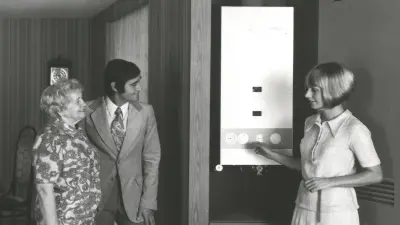A history of Bosch fire alarm systems
Stopping fire in its tracks
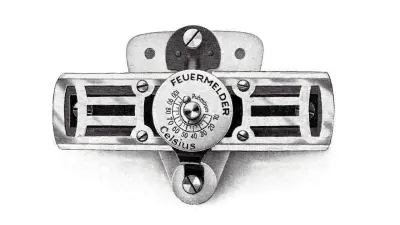
In the event of a fire, every second counts. The sooner a fire alarm system goes off, the better. For decades now, Bosch has been cementing its expertise in the field of fire alarm technology, bringing better and better systems to the market.
The great catastrophe
With flames blazing high into the sky and the scent of burning cloaking the city, the fire that destroyed large parts of Notre-Dame Cathedral in Paris on April 15 and 16, 2019, kept the city’s citizens and culture lovers around the world on tenterhooks. The cause of the fire has yet to be conclusively identified. It cannot be ruled out that a fault in the fire alarm system may have been responsible. How can such disasters be prevented well ahead of time, helping adequately protect important cultural monuments from fire damage?
Protecting monuments
When it comes to fire protection, the people in charge of Aachen Cathedral, another ancient building of inestimable value for cultural history, rely on a modern AI-supported video-based fire detection system from Bosch Building Technologies. The system enables early fire detection and can be individually tailored to the building. Fifty fire detection cameras in 16 rooms identify flames and smoke where ever they occur – no easy task, considering the cathedral’s complex architecture and status as a historical monument. The cameras are now installed so discreetly that visitors do not even notice them when viewing the centuries-old cultural treasure. In addition to fire protection, the AI-supported video-based fire detection system also serves as a burglar alarm and triggers an alert if anyone gets too close to the valuable exhibits.
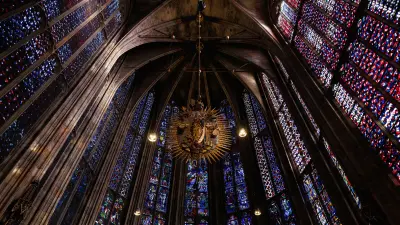
A century of expertise
Bosch has a long tradition of innovative fire alarm systems, which have been part of the company’s product portfolio since the early 1980s. After building up its communications technology division and acquiring Telefonbau und Normalzeit Lehner & Co. (later Telenorma), the company also entered the field of fire alarm technology — something Telefonbau und Normalzeit had decades of experience in prior to the takeover. In fact, one of its predecessor companies, Elektrozeit AG, had already started building fire alarm systems in the 1920s.
Nothing left to chance
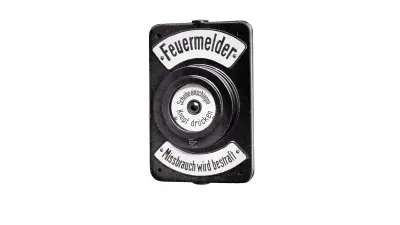
The beginnings of fire alarm technology
At the time, improving protection with technical means was a “hot” topic. The opening lines of a technical description from the period emphasizes the importance of these products: “It is now widely understood that relying merely on human vigilance and luck for the early detection of fires is inadequate; instead, systematic methods must be employed to ensure it. A great many dangerous fires develop quite gradually from seemingly innocuous causes, while many others are caused by spontaneous combustion of heat-generating substances. To put out or even prevent such fires, and to be able to fight sudden, rapidly spreading fires immediately, fire alarm systems — or at least the new ones — are equipped with automatic fire detectors, i.e., heat detectors, in addition to manual call points (push-button detectors).”
Various detection methods
The first automatic detectors responded to heat. At normal temperatures, a heat-sensitive metal strip was in contact with a contact screw and made sure there was no interruption in a closed circuit. A dangerous rise in temperature would cause the metal strip to deform, interrupting the closed circuit and triggering an alarm in the fire alarm control panel. Over the decades that followed, further fire alarm systems that responded to smoke or the flickering of flames and embers would hit the market. Optical fire detectors, the kind most commonly used in homes today, work according to the scattered light principle, where a diode transmits beams of light into the room, which are referred to as a “smokebox.” If there is smoke in the room, the smoke particles reflect back the light beams to a sensor that triggers an alarm when the precisely defined quantity of light has been met or exceeded.
Magic sensors

In 1998, Bosch launched the “Magic Sens,” the first fire detector on the market that combined multiple detection methods and included fire gases for the first time. Fire gases can be detected faster than smoke particles or heat development. Together with ETH Zürich, Bosch had developed a chemical-sensor principle for fire alarm technology that reliably and quickly recognized gases from a fire. The engineers at Bosch knew their way around fine sensors, having spent almost a quarter of a century gaining expertise with gas detectors. Those finely tuned detectors had already played a starring role in the development of the lambda sensor in 1976, which opened the door to exhaust treatment in cars using three-way catalytic converters.
AI for fast help
In 2015, Bosch introduced the video-based “Aviotec” system as a further component for early fire detection. The cameras are capable of providing added safety in spaces where conventional fire detectors face insurmountable obstacles. This became necessary in rooms with very high ceilings or massive building complexes where smoke had to reach the ceiling-mounted detector first. The Aviotec cameras detect the smoke directly at the point of origin. Intelligent algorithms integrated directly into the camera help detect smoke and flames, even in difficult lighting conditions. All that happens within the first few seconds of a fire — and long before smoke and fire gases reach a detector. Thanks to new AI algorithms for video analysis, the Aviotec generation unveiled in 2020 does not require any visible light at all. With that, fire detection has come full circle. Such systems can be individually tailored to different buildings, including important cultural treasures like Aachen Cathedral.
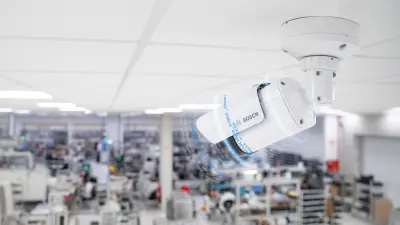
Authors: Bettina Simon / Christine Siegel


